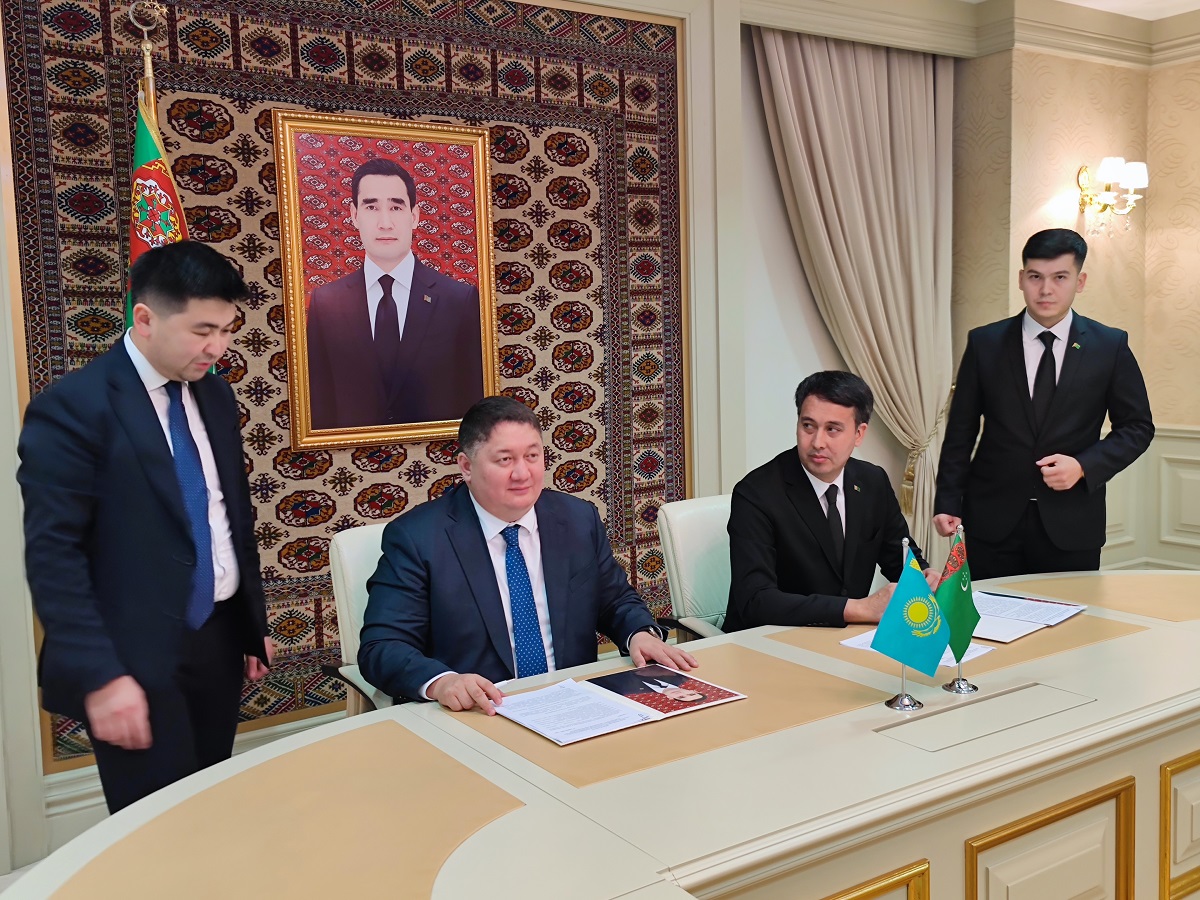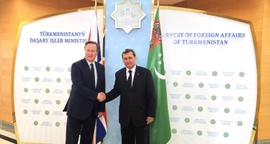The Turkmen and Kazakh senior officials have signed a memorandum of intent on transport links.
The document was signed during the first meeting of the Turkmen-Kazakh working group on transport, transit and logistics in the Turkmen capital Ashgabat on November 26-27, the Turkmen news website Orient.tm reported on November 27.
The meeting of the working group was chaired from the Turkmen side by Deputy Director General of the Agency for Transport and Communications under the Cabinet of Ministers Batyr Annaev, and from the Kazakh side by Vice Minister of Transport Talgat Lastaev.
The document is aimed at expanding and encouraging cooperation to attract traffic volumes across the territories of Turkmenistan and Kazakhstan, including taking joint measures to create favorable tariff conditions, synchronize infrastructure development, and introduce digital solutions for the exchange of preliminary and other information, the report added.
The officials of Turkmenistan's Transport and Communications Agency and Kazakhstan's Ministry of Transport discussed strengthening bilateral relations in road, rail and sea transport during the meeting.
It was also decided to create a permanent working group from representatives of the competent government bodies of the transport industry. To continue the dialogue, the meeting participants agreed to hold the next meeting of the Turkmen-Kazakh Commission on International Road Transport in 2024. The previous meeting of this joint commission was held in the city of Turkmenbashi on September 21, 2023.
On November 3, the Russian Railways Logistics (“RZD Logistics”) company, Kazakhstan Railways (KTZ Express), and the Transport and Logistics Center of Turkmenistan (TULM) signed a memorandum of cooperation in international and transit freight transportation. The sides agreed to develop a joint railway service on the international route “North–South” (INSTC).
Among the main cooperation directions meant by the document were the organization of regular freight traffic in three-sided and transit connection, boosting the international import-export flow of goods, development of the cooperation directed at the realization of the potential of the “North-South” railway corridor, and using jointly the transport and logistics infrastructure.
In addition, the signed document guarantees the development of railway routes by launching new regular trains between Kazakhstan, Turkmenistan and Russia, including regular container services, ensuring short delivery time of agricultural products and consumable goods, also introducing technological innovations and joint solutions on implementation of the route potential.
In October 2022, the “RZD Logistics” company started transportation of full-composite container trains from Russia to Iran on the eastern branch of the North-South land corridor using the transport infrastructure of Turkmenistan.
The INSTC is a multimodal network spanning 7,200 kilometers of ship, rail, and road routes. It is designed to provide the shortest multi-modal transportation route linking the Indian Ocean and the Persian Gulf to the Caspian and Baltic Seas.
Compared to the sea route via the Suez Canal, the INSTC reduces the distance by more than half, resulting in lower transportation costs and shorter transit times. In addition, the INSTC provides an alternative connectivity initiative to countries in the Eurasian region and reduces the time and cost for the transfer of goods from India to Russia and Europe via Iran.
In early November, the head of the Turkmen People's Council, Gurbanguly Berdimuhamedow and Kazakh President Kassym-Jomart Tokayev noted the need to realise the full potential of the China-Kazakhstan-Turkmenistan-Iran transport corridor and to increase the flow of goods between the Kazakh port of Aktau and the Turkmen port of Turkmenbashi on the Caspian Sea.
At the fifth consultative meeting of the Central Asian leaders on September 14, Turkmen President Serdar Berdimuhamedow proposed establishing a common Central Asian transport and logistics platform.
Earlier, the ceremony of laying the foundation of a new road bridge across the Garabogaz Kel Bay along the Turkmenbashi–Garabogaz–Kazakhstan border highway was held in August. The total length of the bridge with two-way two-lane traffic will be 354 meters, width – 21 meters.
This project aimed at realizing the existing transport and transit potential of Turkmenistan and expanding mutually beneficial international trade and economic cooperation.
The Central Asian region, with its limited reach to Western markets due to its geography, has been seeking economic diversification by throwing weight behind various ambitious projects such as China’s Belt and Road Initiative (BRI).
The establishment of logistics centers and free trade zones at the ports of Azerbaijan, Kazakhstan, and Turkmenistan will facilitate the development and deepening of Trans-Caspian cooperation, providing a boost to regional economies. By effectively leveraging the benefits of the Middle Corridor, the countries in the region can reap the rewards of increased trade and economic growth.
The Baku International Sea Trade Port (Azerbaijan), Aktau/Kuryk ports (Kazakhstan) and Turkmenbashi Port (Turkmenistan) are the main maritime points of the Middle Corridor, which promises even bigger benefits to the countries in the region.
Compared to the Northern Corridor, the Middle Corridor provides a more cost-effective and faster trade route, reducing travel distance by 2,000 kilometers. Additionally, it benefits from more favorable climate conditions and reduces travel time by 15 days compared to sea routes.
The Middle Corridor opens up immense opportunities for cargo traffic in Asia, enabling goods to reach the Middle East, North Africa, and the Mediterranean region by integrating port connections in Türkiye. The strategic location of the Middle Corridor is expected to create significant economic opportunities, allowing South Caucasian and Central Asian countries to benefit from the $600 billion China-Europe trade annually.







 Kyrgyzstan has joined the extensive reconstruction efforts in the Karabakh region of Azerbaijan, after a series of mega initiatives were launched b...
Kyrgyzstan has joined the extensive reconstruction efforts in the Karabakh region of Azerbaijan, after a series of mega initiatives were launched b...
 President Ilham Aliyev shed light on the evolving contours of the peace process with Armenia during an international conference in Baku this week. ...
President Ilham Aliyev shed light on the evolving contours of the peace process with Armenia during an international conference in Baku this week. ...
 Azerbaijan and Armenia started the process of demarcation of their border on Tuesday, with the installation of the first border markers based on ge...
Azerbaijan and Armenia started the process of demarcation of their border on Tuesday, with the installation of the first border markers based on ge...
 Iran and Pakistan have signed eight cooperation documents in various fields, and agreed to strengthen ties to fight terrorism in the region.
Iran and Pakistan have signed eight cooperation documents in various fields, and agreed to strengthen ties to fight terrorism in the region.
 As the conflict between Ukraine and Russia escalates, the strategic importance of Kharkiv, Ukraine's second-largest city, has come sharply into focus.
As the conflict between Ukraine and Russia escalates, the strategic importance of Kharkiv, Ukraine's second-largest city, has come sharply into focus.
 Iranian President Ebrahim Raisi expressed Tehran’s readiness to participate in significant development projects in Sri Lanka during the inauguratio...
Iranian President Ebrahim Raisi expressed Tehran’s readiness to participate in significant development projects in Sri Lanka during the inauguratio...



